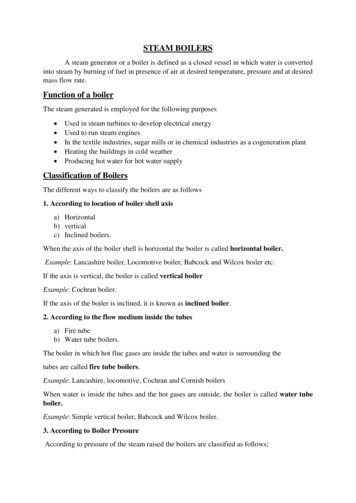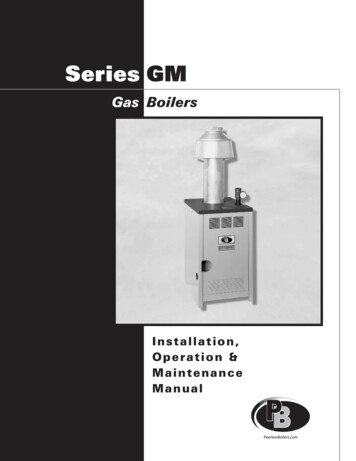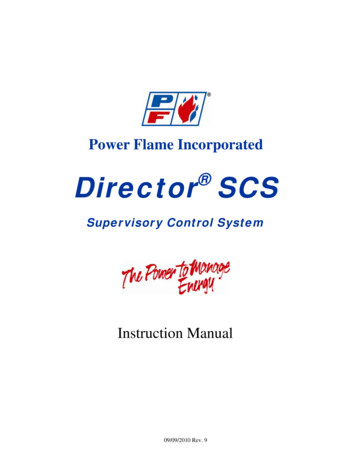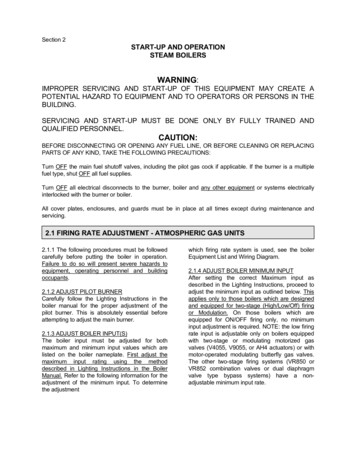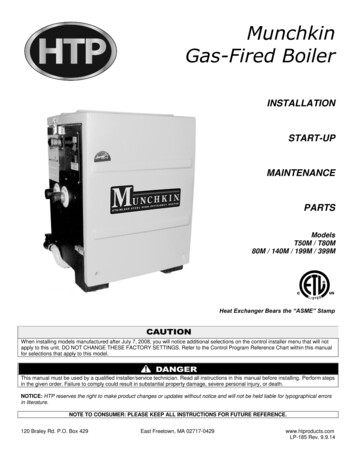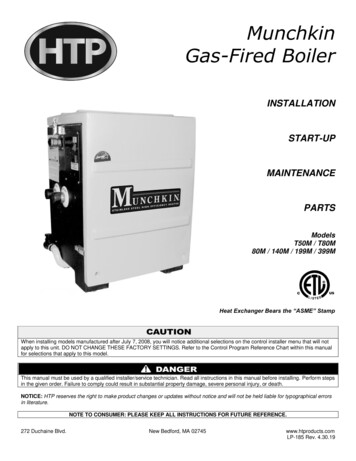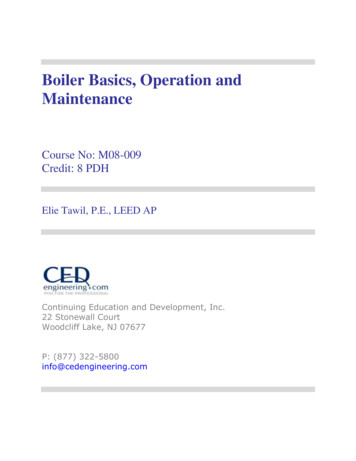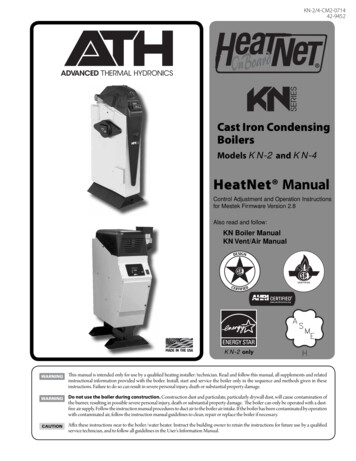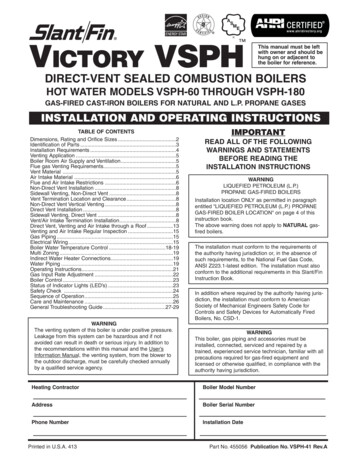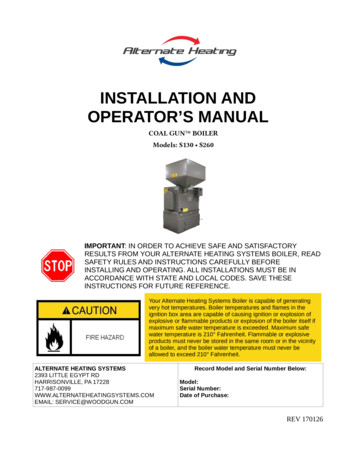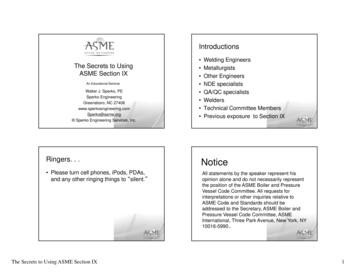
Transcription
IntroductionsThe Secrets to UsingASME Section IXAn Educational SeminarWalter J. Sperko, PESperko EngineeringGreensboro, NC 27406www.sperkoengineering.comSperko@asme.org Sperko Engineering Services, Inc. Welding EngineersMetallurgistsOther EngineersNDE specialistsQA/QC specialistsWeldersTechnical Committee MembersPrevious exposure to Section IXRingers. . .Notice Please turn cell phones, iPods, PDAs,and any other ringing things to “silent.”All statements by the speaker represent hisopinion alone and do not necessarily representthe position of the ASME Boiler and PressureVessel Code Committee. All requests forinterpretations or other inquiries relative toASME Code and Standards should beaddressed to the Secretary, ASME Boiler andPressure Vessel Code Committee, ASMEInternational, Three Park Avenue, New York, NY10016-5990.The Secrets to Using ASME Section IX1
Secrets to be revealed. . . What does Section IX cover? When do you have to use Section IX? The purpose and function of Section IX Relationship of Section IX to other Code Sections How to read Section IX – Organization and Structure How to read Section IX – reading variables Commonly misread procedure qualification variables The biggest lie in the wonderful world of welding Commonly misread performance qualification variables This seminar will not make you a welding engineer.Historical Background Boiler Code Committee was formed in 1911 toprepare a uniform code that could be adopted bylocal jurisdictions for safe design, manufacture andtesting of steam boilers. The first edition of this safety code was published in1914 (Boiler Code). 5 X 8 format, 119 pages The Boiler Code was expanded to include pressurevessels in 1928 (P&PV Code). Section IX (Welding) was added in 1941 toconsolidate welding requirements in theconstruction codes.ASME Construction 31.9B31.11B31.12Rules for Construction of Power BoilersMaterialsNuclear ComponentsHeating BoilersPressure VesselsRules for Inservice Inspection of Nuclear Power PlantsTransport TanksPower PipingProcess PipingLiquid Transportation SystemsRefrigeration PipingGas Transmission and Distribution Piping SystemsBuilding Services PipingSlurry Transportation Piping SystemsHydrogen PipingASME Section I PW-1.2 Responsibility. Each Manufacturer isresponsible for the welding done by hisorganization and shall establish theprocedures and conduct the tests required inSection IX to qualify the welding procedures heuses in the construction of the weldments builtunder Section I and the performance tests ofwelders who apply these procedures.Secret: The Codes listed all refer to Section IX forwelding and brazingThe Secrets to Using ASME Section IX2
Scope of Section IX QW-100 GENERAL “Section IX of the ASME Boiler and PressureVessel Code relates to the qualification of welders,welding operators, brazers, and brazing operators,and the procedures that they employ in weldingand brazing. . . “ Section IX does not deal with fabrication orinspection except that it specifies the minimumcontent of welding procedures that are used forfabrication.Scope of Section IX QW-100 GENERAL “. . . . according to the ASME Boiler and PressureVessel Code and the ASME B31 Code forPressure Piping.” It is compatible with the B&PV code and B31codes; if invoked by other standards (API, NFPA,AWWA, etc.) or directly in a contract, there may bedisconnects (materials, joint configurations, etc).The Secrets to Using ASME Section IXSection IX is different from otherStandards Where Qualificationand Construction Are IntegratedAWS D1.1AWS D1.2AWS D1.3AWS D1.4AWS D1.5AWS D1.6AWS D1.7AWS D1.8AWS D1.9AWS D14.XStructural Welding Code - SteelStructural Welding Code - AluminumStructural Welding Code - Sheet SteelStructural Welding Code - Reinforcing SteelStructural Welding Code - Bridge Welding CodeStructural Welding Code - Stainless SteelGuide for Strengthening/Repairing Existing StructuresStructural Welding Code - Seismic SupplementStructural Welding Code – TitaniumCranes, earthmoving, etc. Equipment weldingAPI 1104.Welding of Pipelines and Related FacilitiesQW-100 QW-100. . . . “Other Sections of the Codemay specify different requirements thanthose specified by this Section. Suchrequirements take precedence over those ofthis Section, and the manufacturer orcontractor shall comply with them.”3
When other Sections refer toSection IX. . . Some have additional requirements (e.g.,Section III) some reduce requirements (e.g., B31Sections) Some have downstream requirements,e.g. B31 code sections have specificrequirements regarding filler metals thatmay be used in production.Section IX vs. Other Sections Secret: Read the applicable constructioncode; it may contain requirements thataffect qualification. This is especiallytrue when impact testing is required.ASME Code Editions and AddendaASME Code Editions and AddendaASME B&PV Codes will be published two-yearannual addenda beginning in 2013. The latestaddenda was published July 1, 2011 andbecome mandatory for use for new constructionJanuary 1, 2012.Secret: Once work starts on a boiler or vessel,the designer works to a specific edition andaddenda, that edition and addenda applies to allthe work done on that boiler or pressure vesselregardless of how long it takes to build it.Applicable edition that applies to a boiler, vesselor piping is based on:1)contract date, unless there is an2)edition and addenda specified in the purchaseorder.Secret: This includes Section IX. But Section IXhas always said the following. . . .The Secrets to Using ASME Section IX4
Life expectancy of a WPS/PQRLife expectancy of a WPS/PQR QW-100.3 “Welding ProcedureSpecifications, Procedure QualificationRecords, and Welder/Welding OperatorPerformance Qualification made inaccordance with the requirements of the1962 Edition or any later Edition ofSection IX may be used in anyconstruction built to the ASME Boiler andPressure Vessel Code or the ASME B31Code for Pressure Piping.” QW-100.3 “Welding ProcedureSpecifications and Welder/WeldingOperator Performance Qualificationrecords meeting the above requirementsdo not need to be amended to includeany variables required by later Editionsand Addenda except as specified in QW-420.1.”Life expectancy of a WPS/PQRLife expectancy of a WPS/PQR Secret: Once WPSs and PQRs arequalified, they are good for pretty muchforever except when impacts are required They may be updated to later editions ofthe code at the manufacturer orcontractor’s option assuming data wasrecorded that supports the revisions (e.g.,GMAW-S) How about except as specified in QW420.1? QW-420.1. When base metals are reassigned toanother P-number by in QW-422 (e.g, P5 became P-5A, P-5B and P-5C around2001 AD), all PQRs listing thereassigned base metals as the testcoupon need to be examined and theWPS they support need to be revised toshow the new P-number -- for new work.The Secrets to Using ASME Section IX5
Life expectancy of a WPS/PQRLife expectancy of a WPS/PQR QW-100.3 “Qualification of new WeldingProcedure Specifications orWelders/Welding Operators andrequalification of existing WeldingProcedure Specifications orWelders/Welding Operators shall be inaccordance with the current Edition (seeForeword) and Addenda of Section IX.” This has been in Section IX since themid-1960s. Secret: All new qualifications are done tocurrent edition and addenda. WPS with multiple PQRs dated over adecade. How about a Vessel designed in 2002that is still being built?ASME CODESINTERPRETATIONSASME issues written replies to inquiriesconcerning interpretation of technical aspects ofthe Code.Secret: Interpretations may not apply to latereditions/addendaThe Secrets to Using ASME Section IXOrganization and Structure QW-100: “It is divided into two parts:Part QW gives requirements for weldingand Part QB contains requirements forbrazing.” QW-XXX Welding Sections QB-XXX Brazing Sections Prior to 1974 rewrite, all Section IXparagraphs began with “Q” (e.g. Q-27)6
Organization and Structure WELDINGQW-1XX General RequirementsQW-2XX Procedure QualificationQW-3XX Welder and Welding OperatorQualificationQW-4XX VariablesQW-5XX Standard Welding Procedures(SWPSs)The Secret to Using Section IXOrganization and Structure BRAZINGQB-1XX General RequirementsQB-2XX Procedure QualificationQB-3XX Welder and Welding OperatorQualificationQB-4XX VariablesThe Secret to Using Section IXAm I concerned about theLet’s say that the objective it to writeand qualify theWELDERWELDING PROCEDURE. . . .or about theYou have a CHOICE. . . .WELDING PROCEDURE?The Secrets to Using ASME Section IX7
The WPS QW-100.1 “Any WPSs used by a manufacturer orcontractor that will have responsible operationalcontrol of production welding shall be– a WPS that has been qualified by thatmanufacturer or contractor in accordance withArticle II (QW-200), or. . . .– it shall be an AWS Standard WeldingProcedure Specification (SWPS) listed inAppendix E and adopted by that manufactureror contractor in accordance with Article V (QW500).”The Secret to Using Section IXQW-5XX Standard WeldingProcedures (SWPSs) SWPSs cover base metals from 1/8 to 1-1/2inches in thickness, GTAW, SMAW andFCAW, P-1 in the as-welded and heat treatedcondition and P-8 to P-8 and P-1 to P-8, aswelded only This section stands alone. Read it, buy theappropriate SWPS(s), perform theDemonstration weld(s). Secret: SWPSs can be purchased at AWS.orgThe Secrets to Using ASME Section IXThe Secret to Using Section IX QW-1XX General Requirements QW-2XX Procedure Qualification QW-3XX Welder and Welding OperatorQualification QW-4XX Variables QW-5XX Standard WeldingProcedures (SWPSs)The Secret to Using Section IX QW-1XX General Requirements QW-2XX Procedure Qualification QW-3XX Welder and Welding OperatorQualification QW-4XX Variables QW-5XX Standard Welding Procedures(SWPSs)8
The Secret to Using Section IX QW-1XX General Requirements QW-2XX Procedure Qualification QW-3XX Welder and Welding OperatorQualification QW-4XX Variables QW-5XX Standard Welding Procedures(SWPSs)The Secret to Using Section IXLet’s say that the objective it to writeand qualify theWELDER OR WELDING OPERATORThe Secrets to Using ASME Section IXThe Secret to Using Section IX QW-1XX General Requirements QW-2XX Procedure Qualification QW-3XX Welder and Welding OperatorQualification QW-4XX Variables QW-5XX Standard Welding Procedures(SWPSs)9
The Secret to Using Section IX QW-1XX General Requirements QW-2XX Procedure Qualification QW-3XX Welder and Welding OperatorQualification QW-4XX Variables QW-5XX Standard Welding Procedures(SWPSs) QW-1XX General Requirements QW-2XX Procedure Qualification QW-3XX Welder and Welding OperatorQualification QW-4XX Variables QW-5XX Standard Welding Procedures(SWPSs)The Secret to Using Section IXThe Procedure or the iedWPSThe Secrets to Using ASME Section IXSWPSReadQW-500WelderInvisible WallThe Secret to Using Section 10
The WPSContents of the WPS QW-100.1 “QW-100.1 A Welding ProcedureSpecification (WPS) is a writtendocument that provides direction to thewelder or welding operator for makingproduction welds in accordance withCode requirements.” Secret: when writing a WPS, remember,you are giving the welder direction “When a WPS is to be prepared by themanufacturer or contractor, it must address, asa minimum, the specific variables, bothessential and nonessential, as provided inArticle II for each process to be used inproduction welding. In addition, when other Sections of the Coderequire notch toughness qualification of theWPS, the applicable supplementary essentialvariables must be addressed in the WPS.”Changes to the WPS QW-200.1 (c) “Changes may be made in the nonessentialvariables of a WPS to suit productionrequirements without requalification providedsuch changes are documented . . . . . This maybe by amendment to the WPS or by use of anew WPS.” Revisions, supplemental cover sheets, notes ondrawings can be considered amendments.The Secrets to Using ASME Section IX11
Changes to the WPS QW-200.1 (c) “Changes in essential or supplementaryessential (when required) variables requirerequalification of the WPS (new or additionalPQRs to support the change in essential orsupplementary essential variables).”Changes to the WPS QW-200.1 When an essential or supplementary essentialvariables is changed, additional PQR(s) arerequired to support the change and the WPSmust also be revised by amendment to the WPSor by use of a new WPS. Example: addition of PWHTThe Secrets to Using ASME Section IX12
Format of the WPS QW-200.1 (d) “The information required to be in the WPSmay be in any format, written or tabular, to fitthe needs of each manufacturer or contractor,as long as every essential, nonessential, and,when required, supplementary essentialvariables outlined in QW-250 through QW-280is included (on the WPS) or referenced (to someother document by the WPS).”Intrinsically Addressed matters. . .Indicate Gender Male Female What was the date of your lastpregnancy If “Male” is checked, the date ofpregnancy is intrinsically addressed .The Secrets to Using ASME Section IXThe contents of the WPS Every essential and nonessential variable has tobe addressed on the WPS – always! Supplementary essential variables have to beaddressed ONLY when the construction coderequires the WPS to be qualified with impacttesting. Some variables are addressed intrinsically byaddressing other variables, e.g., QW-410.64addresses use of torch cutting for P-11A and P11B materials; if the base metals that the WPSspecifies are P-1, there is no need to specificallyaddress QW-410.64 in the WPSQW-100.1, The PQR “The purpose for qualification of a WPSis to determine that the weldmentproposed for construction is capable ofproviding the required properties for itsintended application. Welding procedurequalification establishes the propertiesof the weldment, not the skill of thewelder or welding operator.” Secret: this is the basis the committeeuses to identify essential variables.13
QW-100.1, The PQR“The Procedure Qualification Record (PQR)documents what occurred during welding thetest coupon and the results of testing of thecoupon. As a minimum, the PQR shalldocument the essential variables and other specificinformation identified in Article II for eachprocess used during welding the test couponand the results of the required testing.”QW-100.1, The PQR continued. . . . . and other specific information identified inArticle II. . . See QW-200.2(b) “One or more combinations of weldingprocesses, filler metal, and other variablesmay be used when welding a test coupon.The approximate thickness of weld metaldeposited shall be recorded for each processand for each set of essential and, whenrequired, supplementary essential variables.”The Secrets to Using ASME Section IXQW-100.1, The PQR “In addition, when notch toughnesstesting is required for procedurequalification, the applicablesupplementary essential variables foreach process shall be recorded.”14
Notch-Toughness Tests “QW-171.1 General. Charpy V-notch impacttests shall be made when required by otherSections. Test procedures and apparatusshall conform to the requirements of SA-370. QW-171.2 Acceptance. The acceptancecriteria shall be in accordance with thatSection specifying impact requirements.” Test temperature, acceptance criteria mustbe provided by that SectionNotch-Toughness Tests “QW-171.3 Location and Orientation of TestSpecimen. The impact test specimen andnotch location and orientation shall be as givenin the Section requiring such tests.” Secret: The Section tells you what to test: weldmetal, HAZ, the base metal, where to removedspecimens relative to depth of the coupon,how many specimens, Temperature,acceptance criteria, etc.The Secrets to Using ASME Section IXQW-200.2 The PQR “The PQR is a record of variablesrecorded during the welding of the testcoupons. It also contains the test resultsof the tested specimens.15
QW-200.2 The PQR “(b) Contents of the PQR. Thecompleted PQR shall document allessential and, when required,supplementary essential variables ofQW-250 through QW-280 for eachwelding process used during the weldingof the test coupon.”QW-200.2 The PQRQW-200.2 The PQR “Nonessential or other variables usedduring the welding of the test couponmay be recorded at the manufacturer’sor contractor’s option.” Recording some nonessential variablesfills out the PQR. Recording them does not affect what youcan put on the WPS regardingnonessential variables. Secret: Complete PQRs in the past tense “All variables, if recorded, shall be theactual variables (including ranges) usedduring the welding of the test coupon.The Secrets to Using ASME Section IX If variables are not monitored duringwelding, they shall not be recorded.” Implication?16
QW-200.2 The PQRQW-200.2 The PQR “(c) Changes to the PQR. Changes tothe PQR are not permitted.” Historical Record Typos Code changes P-number is reassigned Annotate Certify “(d) Format of the PQR. The informationrequired to be in the PQR may be in anyformat . . . as long as every essentialand, when required, supplementaryessential variable required by QW-250through QW-280, is included. Also the type of tests, number of tests,and test results shall be listed in thePQR.QW-200.2 The PQRQW-201 Manufacturer’s orContractor’s Responsibility “(e) Availability of the PQR. PQRs usedto support WPSs shall be available, uponrequest, for review by the AuthorizedInspector (AI). The PQR need not be available to thewelder or welding operator. The welders or welding operators usedto produce weldments to be tested forqualification of procedures shall be underthe full supervision and control of themanufacturer or contractor during theproduction of these test weldments. How about the WPS?The Secrets to Using ASME Section IX17
QW-201 Manufacturer’s orContractor’s ResponsibilityQW-201 Manufacturer’s orContractor’s ResponsibilityThe weldments to be tested for qualificationof procedures shall be welded either byIt is not permissible for the manufacturer orcontractor to have the supervision andcontrol of welding of the test weldmentsperformed by another organization.–direct employees or–by individuals engaged by contract for theirservices as welders or welding operators–under the full supervision and control of themanufacturer or contractor.QW-201 Manufacturer’s orContractor’s ResponsibilityWho has to qualify the WPSs?The manufacturer or contractor that has first-lineresponsibility for supervising the welders who doproduction welding is the organization that has toqualify the WPS.How about Welders?Same provisions apply to welder qualification –the organization that supervises the welders isthe organization that has to qualify the welders.The Secrets to Using ASME Section IXQW-250 WELDING VARIABLES “QW-251.1 Types of Variables forWelding Procedure Specifications.These variables listed for each weldingprocess are subdivided into essential,supplementary essential andnonessential variables.18
QW-250 WELDING VARIABLESQW-250 WELDING VARIABLESQW-250 WELDING VARIABLESQW-250 WELDING VARIABLESSECRET:The Secrets to Using ASME Section IX19
QW-250 WELDING VARIABLESQW-250 WELDING VARIABLES “QW-251.1 Types of Variables forWelding Procedure Specifications. The “Brief of Variables” listed in thetables are for reference only. See thecomplete variable in Welding Data ofArticle IV.(QW-400)” Secret: the “brief of variables” is not thevariable!QW-250 WELDING VARIABLESHow do you read variables? “QW-251.4 Special Processes (a) The special process essentialvariables for corrosion resistant andhard-surfacing weld metal overlays areas indicated in the following tables for thespecified process. Only the variablesspecified for special processes shallapply.The Secrets to Using ASME Section IX20
QW-402.1A change in the Type ofGroove (Vee-groove, Ugroove, single bevel,double bevel, etc.)What if QW-402.1 was Essential?A change in the Type ofGroove (Vee-groove, Ugroove, single bevel,double bevel, etc.)is an essentialvariableThe Secrets to Using ASME Section IXQW-402.1 -- How to read it!A change in the Type ofGroove (Vee-groove, Ugroove, single bevel,double bevel, etc.)is a nonessential variable. .NQW-402.10A change in the specifiedroot spacing is anonessential variable. . . .21
What if . . . .QW-402.10 was essential?A change in the specifiedroot spacing is anessential variable!!!!Secret: Base metal “T” vs Weld metal “t”The Secrets to Using ASME Section IXEQW-403.8A change in the base metalthickness beyond the rangequalified in QW-451, is anessential variable. . .Illustrations of QW-451.1 forSingle process coupons22
Illustrations of QW-451.1 forMultiple process couponsSecret: not all processes refer toQW-451 QW-403.2 OFW The maximum thicknessqualified is the thickness of thetest coupon. Never gets to QW-451. . .Secret: Base metal “T” vs Weld deposit “t”QW-200.4 Combination ofWelding ProceduresQW-200.4 Combination ofWelding Procedures (a) More than one WPS having differentessential, supplementary essential, ornonessential variables may be used in asingle production joint. Each WPS may include one or acombination of processes, filler metals,or other variables. (a) Where more than one WPSspecifying different processes, fillermetals, or other essential orsupplementary essential variables isused in a joint, QW-451 shall be used todetermine the range of base metalthickness and maximum weld metalthickness qualified for each process, fillermetal, or set of variables, and thoselimits shall be observed.The Secrets to Using ASME Section IX23
QW-403.11QW-424 Base metals specified in the WPS shallbe qualified by a procedure qualificationtest that was made using base metals inaccordance with QW-424.Base metals are assigned P-Numbers intable QW/QB-422; metals that do notappear in table QW/QB-422 areconsidered to be unassigned metalsexcept as otherwise defined for basemetals having the same UNS numbers.QW-420 P-numbers QW-420 BASE METAL GROUPINGS P-Numbers are alphanumeric designations:accordingly, each P-Number shall be considered aseparate P-Number (e.g., base metals assigned PNo. 5A are considered a separate P-Number fromthose assigned P-No. 5B or P-No. 5C).The Secrets to Using ASME Section IX24
QW-420 P-numbers “If an unlisted base metal has the same UNSnumber designation as a base metal listed intable QW/QB-422, it shall be considered asassigned to that P-Number or P-Number plusGroup Number. Secret: For welding purposes, ASTM versionsof specifications have the same UNS numberhave the same P-number as the ASMEspecification material.The Secrets to Using ASME Section IXOther Listings for P-Numbers B&PV Code and B31 Piping CodeAllowable Stress Table assignmentscome from Subcommittee IX www.pnumbers.com, a fully sortable andsearchable listing supported by C-Spec.25
Table QW-424.1 – THE BASIC RULESBase Metal(s) Used forProcedure QualificationCouponBase Metals QualifiedOne metal from a P-Number to Any metal assigned that Pany any metal from the same P- NumberNumberOne metal from a P-Number toany metal from any other PNumberAny metal assigned the first Pnumber to any metal assignedthe second P-numberAny unassigned metal to thesame unassigned metalThe unassigned metal to itselfAny unassigned metal to any P- The unassigned metal to anynumber metalmetal assigned to the same PNumber as the qualified metalAny unassigned metal to anyother unassigned metalEQW-404.4 A change from one F-Number inQW-432 to any other F-Numberor to any other filler metal notlisted in QW-432. (F-number Filler Number) Secret: Section IX does not tellyou what filler metal to useThe first unassigned metal tothe second unassigned metalEQW-404.4 A change from one F-Number inQW-432 to any other F-Numberor to any other filler metal notlisted in QW-432. Secret 1: you can use any fillermetal you can qualify Secret 2: Filler metals do nothave to have F-numbersThe Secrets to Using ASME Section IX26
EQW-403.9 The most commonly missed essentialvariable. . . .For single-pass or multi-passwelding in which any pass isgreater than 1/2 inch (13 mm)thick, an increase in base metalthickness beyond 1.1 times thatof the qualification test couponis an essential Variable.EQW-403.9To address this variable The PQR needs to record: “No passexceeded ½ in (13 mm) in thickness” The WPS needs to say: “No pass mayexceed ½ inch (13 mm) in thickness.”Optimum W/D ratio is 3:2The Secrets to Using ASME Section IX27
Miscellaneous Secret 1Miscellaneous Secret 2 QW-203 Position Qualification in any position qualifies theWPS for all positions except as requiredotherwise in the essential variables forthe process (i.e., when impact testing isrequired, then test coupon must bewelded vertical uphill if it is to be usedvertical uphill). The process must besuitable for the positions permitted. QW-211 Base Metal The base metals may consist of eitherplate, pipe, or other product forms.Qualification in plate also qualifies forpipe welding and vice versa. Not true for welders. . . . They are on theother side of the invisible wall.Miscellaneous Secret 3Miscellaneous Secret 3 QW-401.3 When a procedure has beenpreviously qualified to satisfy allrequirements other than notchtoughness, it is then necessary only toprepare an additional test coupon usingthe same procedure with the sameessential variables, but additionally withall of the required supplementaryessential variables, with the coupon longenough to provide the necessary notchtoughness specimens. Secret: WPSs that are already qualified bytension and bend test can be upgraded forimpact tested applications by welding a testcoupon big enough to remove the impacttest specimens following that WPS plus thesupplementary essential variables. Repeating tension and bend tests is notnecessary provided the existing WPS isfollowed.The Secrets to Using ASME Section IX28
Performance Qualification QW-300.1 This Article lists the weldingprocesses separately, with the essentialvariables which apply to welder andwelding operator performancequalifications.The Secrets to Using ASME Section IX29
Performance Qualificaiton The welder qualification is limited by theessential variables given for eachwelding process. These variables arelisted in QW-350, and are defined inArticle IV Welding Data (QW-400). The welding operator qualification islimited by the essential variables given inQW-360 for each type of weld.ASME Section IX DistinctionBetween Welder and WeldingOperator Welder- one who performs a manualor semi-automatic welding operation. Welding Operator -one whooperates machine or automatic weldingequipmentWelder vs. Operator Manual Welding -welding whereinthe entire welding operation isperformed and controlled by hand Semiautomatic arc welding -arcwelding with equipment whichcontrols only the filler metal feed.The advance of the welding ismanually controlled.The Secrets to Using ASME Section IX30
Welder vs. Operator Machine Welding -welding withequipment which performs the weldingoperation under the constantobservation and control of a weldingoperator. Automatic Welding -welding withequipment which performs the weldingoperation without adjustment of thecontrols by a welding operator.Performance QualificationPerformance Qualification A welder or welding operator may be qualifiedby volumetric NDE of a test coupon or theirinitial production welding within the limitationsof QW-304 and QW-305 or by bend teststaken from a test coupon. Secret: Qualification by removal of bendspecimens from production welds is notpermitted The welders or welding operators . . . shall betested under the full supervision andcontrol of the manufacturer. . . . during theproduction of these test weldments. It is notpermissible for the manufacturer. . . .to havethe welding performed by anotherorganization.The Secrets to Using ASME Section IX31
Performance QualificationSupervision and Control . . . . .shall be tested under the full supervisionand control of the manufacturer. . . . during theproduction of these test weldments. Are there any qualifications for the person whoprovides “supervision and control?” What is “supervision and control?” The test supervisor should be capable ofidentifying, verifying and recording theinformation that will be entered on theQW/QB-484 form since it will be certifiedas correct by the manufacturer orcontractor.Records QW-301.4 Record of Tests. The record . . .shall include the essential variables (QW-350 or QW360) type of test and test results ranges qualified in accordance with QW452 for each welder and welding operator. A suggested form for these records is givenin Form QW-484 (see NonmandatoryAppendix B). Certifying SignatureThe Secrets to Using ASME Section IX32
Testing ProcessTesting Process QW-30l.2 Qualification Tests. Eachmanufacturer or contractor shall qualifyeach welder or welding operator for eachwelding process to be used in productionwelding. QW-30l.2 Qualification Tests. The performance qualification test (coupon)shall be welded in accordance with a qualifiedWelding Procedure Specifications (WPS),except that when performance qualification isdone in accordance with a WPS that requires apreheat or postweld heat treatment, these maybe omitted. (A WPS must be followed during the test)Testing Process QW-30l.2 Qualification Tests. Changes beyond whichrequalification is required are givenin– QW-350 for welders and in– QW-360 for welding operators.The Secrets to Using ASME Section IX33
Biggest lie in the welding industryWelders “A welder is qualified to a procedure. .” A WPS must be followed during the test,but the WPS followed does not limit whatthe welder is qualified to do
AWS D1.5 Structural Welding Code - Bridge Welding Code AWS D1.6 Structural Welding Code - Stainless Steel AWS D1.7 Guide for Strengthening/Repairing Existing Structures AWS D1.8 Structural Welding Code - Seismic Supplement AWS D1.9 Structural Welding Code - Titanium AWS D14.X Cranes, earthmoving, etc. Equipment welding
